2008 BMW 335XI SEDAN tire size
[x] Cancel search: tire sizePage 216 of 274
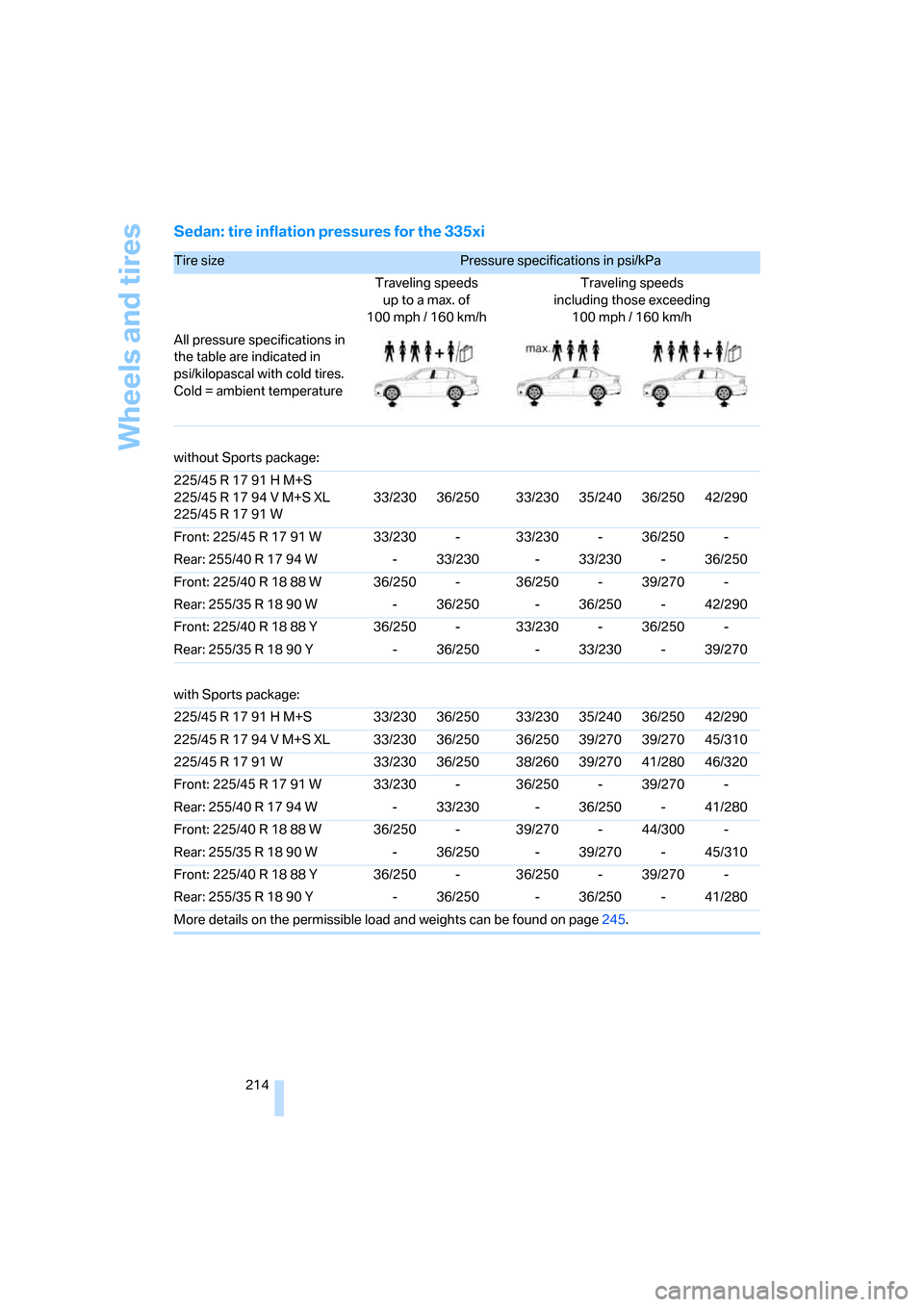
Wheels and tires
214
Sedan: tire inflation pressures for the 335xi
Tire size Pressure specifications in psi/kPa
Traveling speeds
up to a max. of
100mph / 160km/hTraveling speeds
including those exceeding
100 mph / 160 km/h
All pressure specifications in
the table are indicated in
psi/kilopascal with cold tires.
Cold = ambient temperature
without Sports package:
225/45 R 17 91 H M+S
225/45 R 17 94 V M+S XL
225/45 R 17 91 W33/230 36/250 33/230 35/240 36/250 42/290
Front: 225/45 R 17 91 W 33/230 - 33/230 - 36/250 -
Rear: 255/40 R 17 94 W - 33/230 - 33/230 - 36/250
Front: 225/40 R 18 88 W 36/250 - 36/250 - 39/270 -
Rear: 255/35 R 18 90 W - 36/250 - 36/250 - 42/290
Front: 225/40 R 18 88 Y 36/250 - 33/230 - 36/250 -
Rear: 255/35 R 18 90 Y - 36/250 - 33/230 - 39/270
with Sports package:
225/45 R 17 91 H M+S 33/230 36/250 33/230 35/240 36/250 42/290
225/45 R 17 94 V M+S XL 33/230 36/250 36/250 39/270 39/270 45/310
225/45 R 17 91 W 33/230 36/250 38/260 39/270 41/280 46/320
Front: 225/45 R 17 91 W 33/230 - 36/250 - 39/270 -
Rear: 255/40 R 17 94 W - 33/230 - 36/250 - 41/280
Front: 225/40 R 18 88 W 36/250 - 39/270 - 44/300 -
Rear: 255/35 R 18 90 W - 36/250 - 39/270 - 45/310
Front: 225/40 R 18 88 Y 36/250 - 36/250 - 39/270 -
Rear: 255/35 R 18 90 Y - 36/250 - 36/250 - 41/280
More details on the permissible load and weights can be found on page245.
Page 217 of 274
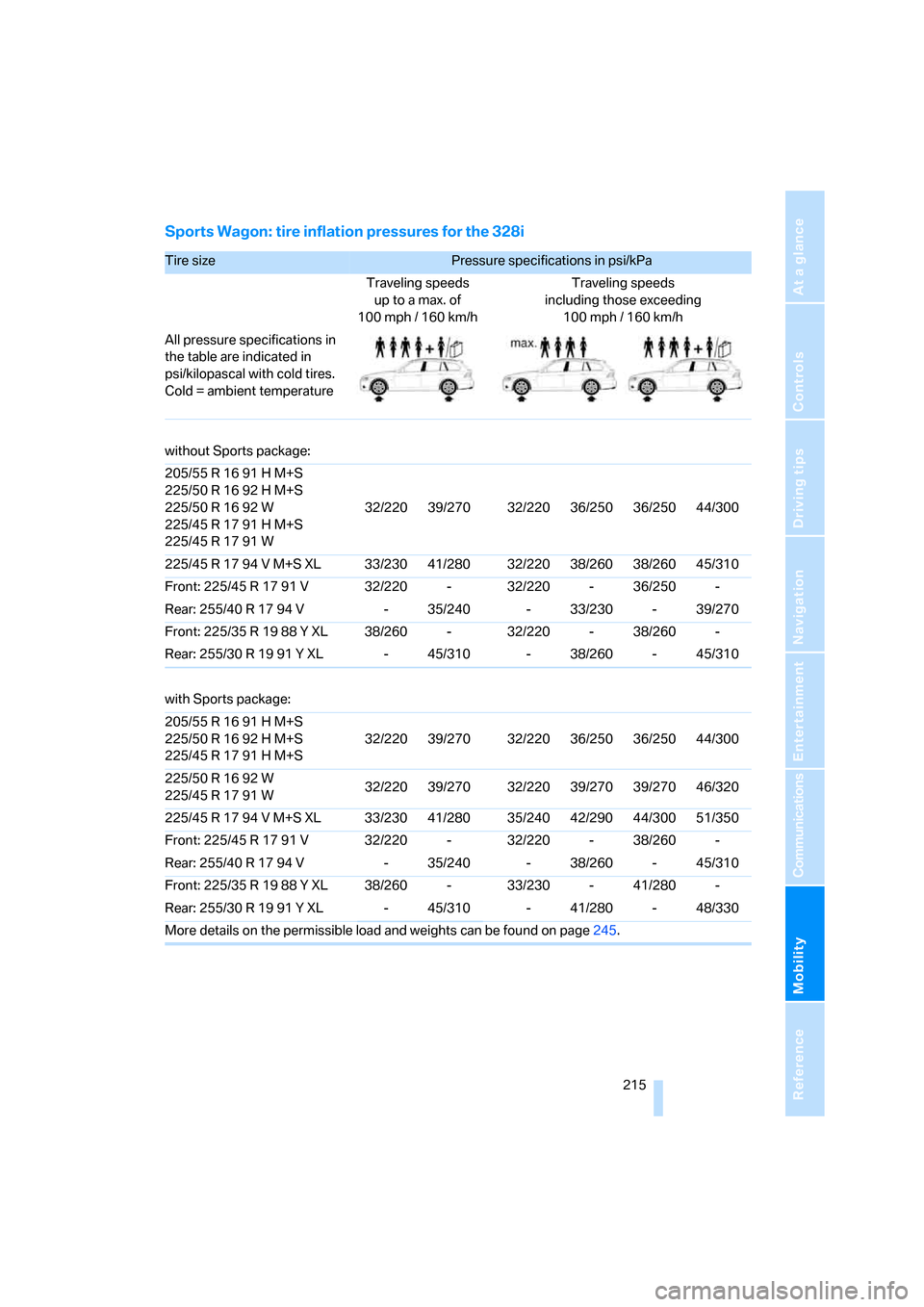
Mobility
215Reference
At a glance
Controls
Driving tips
Communications
Navigation
Entertainment
Sports Wagon: tire inflation pressures for the 328i
Tire size Pressure specifications in psi/kPa
Traveling speeds
up to a max. of
100 mph / 160 km/hTraveling speeds
including those exceeding
100mph / 160km/h
All pressure specifications in
the table are indicated in
psi/kilopascal with cold tires.
Cold = ambient temperature
without Sports package:
205/55 R 16 91 H M+S
225/50 R 16 92 H M+S
225/50 R 16 92 W
225/45 R 17 91 H M+S
225/45 R 17 91 W32/220 39/270 32/220 36/250 36/250 44/300
225/45 R 17 94 V M+S XL 33/230 41/280 32/220 38/260 38/260 45/310
Front: 225/45 R 17 91 V 32/220 - 32/220 - 36/250 -
Rear: 255/40 R 17 94 V - 35/240 - 33/230 - 39/270
Front: 225/35 R 19 88 Y XL 38/260 - 32/220 - 38/260 -
Rear: 255/30 R 19 91 Y XL - 45/310 - 38/260 - 45/310
with Sports package:
205/55 R 16 91 H M+S
225/50 R 16 92 H M+S
225/45 R 17 91 H M+S32/220 39/270 32/220 36/250 36/250 44/300
225/50 R 16 92 W
225/45 R 17 91 W32/220 39/270 32/220 39/270 39/270 46/320
225/45 R 17 94 V M+S XL 33/230 41/280 35/240 42/290 44/300 51/350
Front: 225/45 R 17 91 V 32/220 - 32/220 - 38/260 -
Rear: 255/40 R 17 94 V - 35/240 - 38/260 - 45/310
Front: 225/35 R 19 88 Y XL 38/260 - 33/230 - 41/280 -
Rear: 255/30 R 19 91 Y XL - 45/310 - 41/280 - 48/330
More details on the permissible load and weights can be found on page245.
Page 218 of 274

Wheels and tires
216
Sports Wagon: tire inflation pressures for the 328xi
Tire size Pressure specifications in psi/kPa
Traveling speeds
up to a max. of
100mph / 160km/hTraveling speeds
including those exceeding
100 mph / 160 km/h
All pressure specifications in
the table are indicated in
psi/kilopascal with cold tires.
Cold = ambient temperature
without Sports package:
205/55 R 16 91 H M+S
225/50 R 16 92 H M+S
225/50 R 16 92 W
225/45 R 17 91 H M+S
225/45 R 17 94 V M+S XL
225/45 R 17 91 W32/220 39/270 32/220 38/260 36/250 44/300
Front: 225/45 R 17 91 V 32/220 - 32/220 - 36/250 -
Rear: 255/40 R 17 94 V - 35/240 - 32/220 - 39/270
with Sports package:
205/55 R 16 91 H M+S
225/50 R 16 92 H M+S
225/45 R 17 91 H M+S32/220 39/270 32/220 38/260 36/250 44/300
225/50 R 16 92 W
225/45 R 17 91 W32/220 39/270 33/230 39/270 39/270 46/320
225/45 R 17 94 V M+S XL 32/220 39/270 35/240 42/290 42/290 49/340
Front: 225/45 R 17 91 V 32/220 - 33/230 - 38/260 -
Rear: 255/40 R 17 94 V - 35/240 - 36/250 - 44/300
More details on the permissible load and weights can be found on page245.
Page 219 of 274
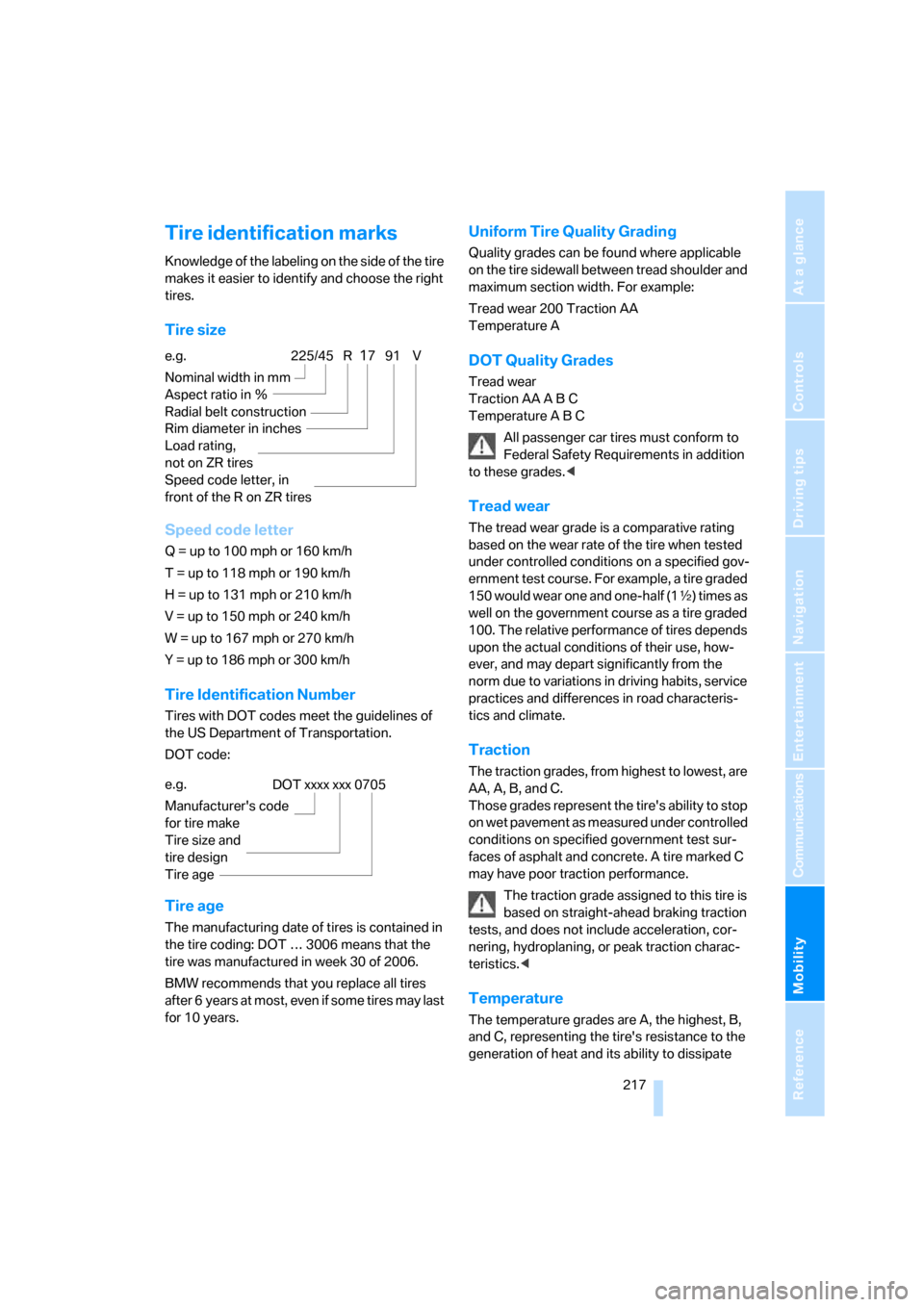
Mobility
217Reference
At a glance
Controls
Driving tips
Communications
Navigation
Entertainment
Tire identification marks
Knowledge of the labeling on the side of the tire
makes it easier to identify and choose the right
tires.
Tire size
Speed code letter
Q = up to 100 mph or 160 km/h
T = up to 118 mph or 190 km/h
H = up to 131 mph or 210 km/h
V = up to 150 mph or 240 km/h
W = up to 167 mph or 270 km/h
Y = up to 186 mph or 300 km/h
Tire Identification Number
Tires with DOT codes meet the guidelines of
the US Department of Transportation.
DOT code:
Tire age
The manufacturing date of tires is contained in
the tire coding: DOT … 3006 means that the
tire was manufactured in week 30 of 2006.
BMW recommends that you replace all tires
after 6 years at most, even if some tires may last
for 10 years.
Uniform Tire Quality Grading
Quality grades can be found where applicable
on the tire sidewall between tread shoulder and
maximum section width. For example:
Tread wear 200 Traction AA
Temperature A
DOT Quality Grades
Tread wear
Traction AA A B C
Temperature A B C
All passenger car tires must conform to
Federal Safety Requirements in addition
to these grades.<
Tread wear
The tread wear grade is a comparative rating
based on the wear rate of the tire when tested
under controlled conditions on a specified gov-
ernment test course. For example, a tire graded
150 would wear one and one-half (1γ) times as
well on the government course as a tire graded
100. The relative performance of tires depends
upon the actual conditions of their use, how-
ever, and may depart significantly from the
norm due to variations in driving habits, service
practices and differences in road characteris-
tics and climate.
Traction
The traction grades, from highest to lowest, are
AA, A, B, and C.
Those grades represent the tire's ability to stop
on wet pavement as measured under controlled
conditions on specified government test sur-
faces of asphalt and concrete. A tire marked C
may have poor traction performance.
The traction grade assigned to this tire is
based on straight-ahead braking traction
tests, and does not include acceleration, cor-
nering, hydroplaning, or peak traction charac-
teristics.<
Temperature
The temperature grades are A, the highest, B,
and C, representing the tire's resistance to the
generation of heat and its ability to dissipate e.g.
Nominal width in mm
Aspect ratio in Ξ
Radial belt construction
Rim diameter in inches
Load rating,
not on ZR tires
Speed code letter, in
front of the R on ZR tires
225/45 R1791 V
e.g.
Manufacturer's code
for tire make
Tire size and
tire design
Tire ageDOT xxxx xxx 0705
Page 221 of 274
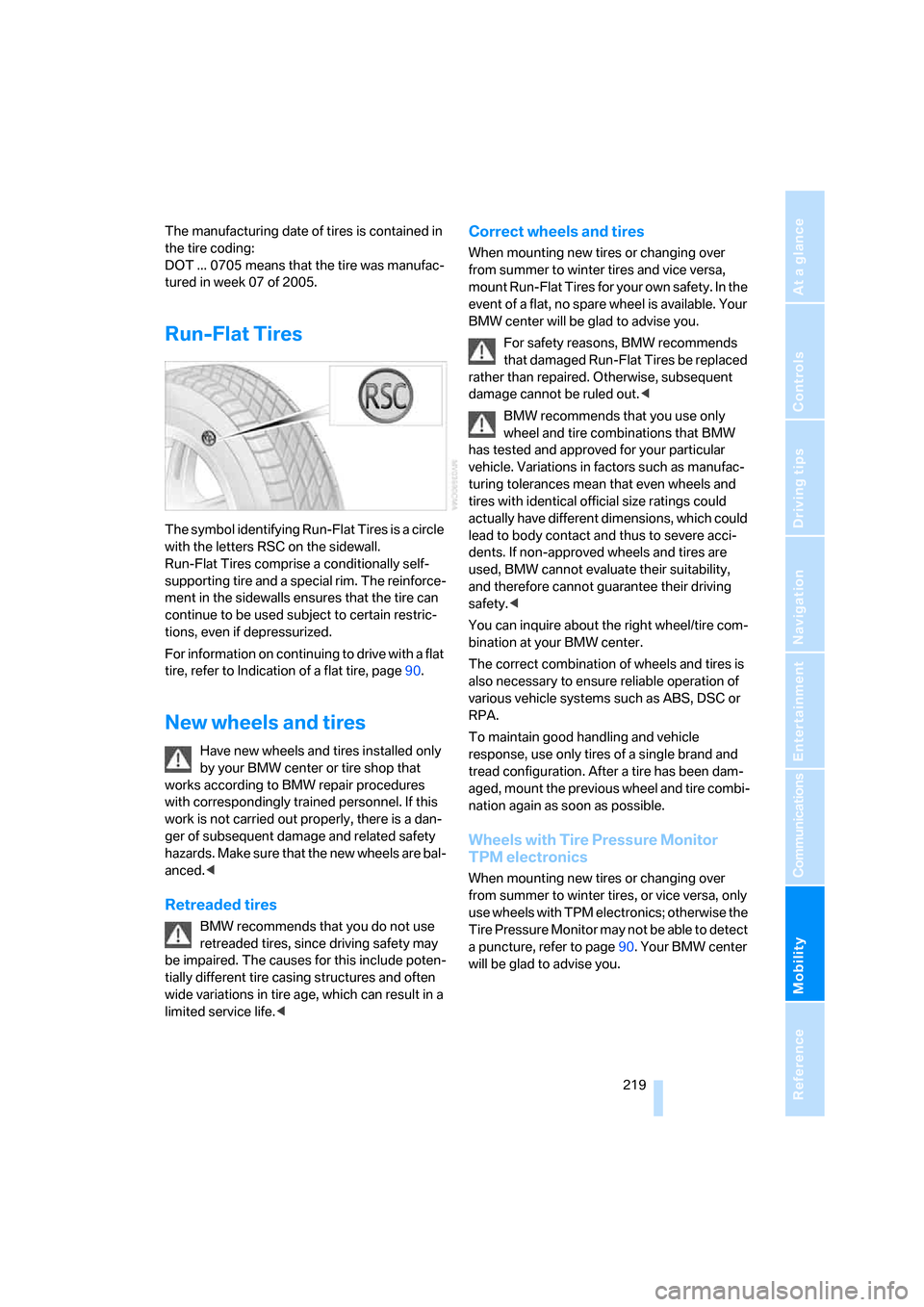
Mobility
219Reference
At a glance
Controls
Driving tips
Communications
Navigation
Entertainment
The manufacturing date of tires is contained in
the tire coding:
DOT ... 0705 means that the tire was manufac-
tured in week 07 of 2005.
Run-Flat Tires
The symbol identifying Run-Flat Tires is a circle
with the letters RSC on the sidewall.
Run-Flat Tires comprise a conditionally self-
supporting tire and a special rim. The reinforce-
ment in the sidewalls ensures that the tire can
continue to be used subject to certain restric-
tions, even if depressurized.
For information on continuing to drive with a flat
tire, refer to Indication of a flat tire, page90.
New wheels and tires
Have new wheels and tires installed only
by your BMW center or tire shop that
works according to BMW repair procedures
with correspondingly trained personnel. If this
work is not carried out properly, there is a dan-
ger of subsequent damage and related safety
hazards. Make sure that the new wheels are bal-
anced.<
Retreaded tires
BMW recommends that you do not use
retreaded tires, since driving safety may
be impaired. The causes for this include poten-
tially different tire casing structures and often
wide variations in tire age, which can result in a
limited service life.<
Correct wheels and tires
When mounting new tires or changing over
from summer to winter tires and vice versa,
mount Run-Flat Tires for your own safety. In the
event of a flat, no spare wheel is available. Your
BMW center will be glad to advise you.
For safety reasons, BMW recommends
that damaged Run-Flat Tires be replaced
rather than repaired. Otherwise, subsequent
damage cannot be ruled out.<
BMW recommends that you use only
wheel and tire combinations that BMW
has tested and approved for your particular
vehicle. Variations in factors such as manufac-
turing tolerances mean that even wheels and
tires with identical official size ratings could
actually have different dimensions, which could
lead to body contact and thus to severe acci-
dents. If non-approved wheels and tires are
used, BMW cannot evaluate their suitability,
and therefore cannot guarantee their driving
safety.<
You can inquire about the right wheel/tire com-
bination at your BMW center.
The correct combination of wheels and tires is
also necessary to ensure reliable operation of
various vehicle systems such as ABS, DSC or
RPA.
To maintain good handling and vehicle
response, use only tires of a single brand and
tread configuration. After a tire has been dam-
aged, mount the previous wheel and tire combi-
nation again as soon as possible.
Wheels with Tire Pressure Monitor
TPM electronics
When mounting new tires or changing over
from summer to winter tires, or vice versa, only
use wheels with TPM electronics; otherwise the
Tire Pressure Monitor may not be able to detect
a puncture, refer to page90. Your BMW center
will be glad to advise you.
Page 222 of 274

Wheels and tires
220
Recommended tire brands
Certain makes of tire are recommended by
BMW for each tire size. They are marked with a
clearly visible BMW designation on the sidewall
of the tire.
When properly used, these tires meet the high-
est standards in terms of safety and handling
characteristics.
Special characteristics of winter tires
BMW recommends winter tires for use in cold
winter driving conditions. Although all-season
M+S tires provide better winter traction than
summer tires, they generally fail to provide the
same levels of cold-weather performance as
winter tires.
Pay attention to speed
Always comply with the speed limit for the
winter tires mounted on your car; failure
to do so could result in tire damage and acci-
dents.<
If the car is capable of speeds higher than that
permitted for the winter tires, a label stating the
maximum permitted speed for the mounted
tires must be displayed in your field of view.
Specialist tire dealers and your BMW center
can supply these labels.
Storage
Always store wheels and tires in a cool, dry
place with as little exposure to light as possible.
Always protect tires against all contact with oil,
grease and fuels. Do not exceed the maximum
tire inflation pressure indicated on the sidewall
of the tire.
Swapping wheels between axles
BMW advises against swapping wheels
between the front and rear axles, even if all tires
have the same size, as this could impair driving
characteristics. If the tires are of mixed sizes,
swapping wheels between the axles is not per-
missible.
Snow chains*
Only certain fine-link snow chains have been
tested by BMW, classified as safe for use and
recommended. Consult your BMW center for
more information.
Snow chains must be mounted in pairs and on
the rear wheels only. Observe the manufac-
turer's instructions when mounting snow
chains. Do not exceed a speed of 30 mph or
50 km/h.
Do not initialize the Flat Tire Monitor if
snow chains are mounted, otherwise the
instrument might issue an incorrect reading.
When driving with snow chains, you may find it
helpful to activate DTC temporarily, refer to
page87.<
Page 269 of 274
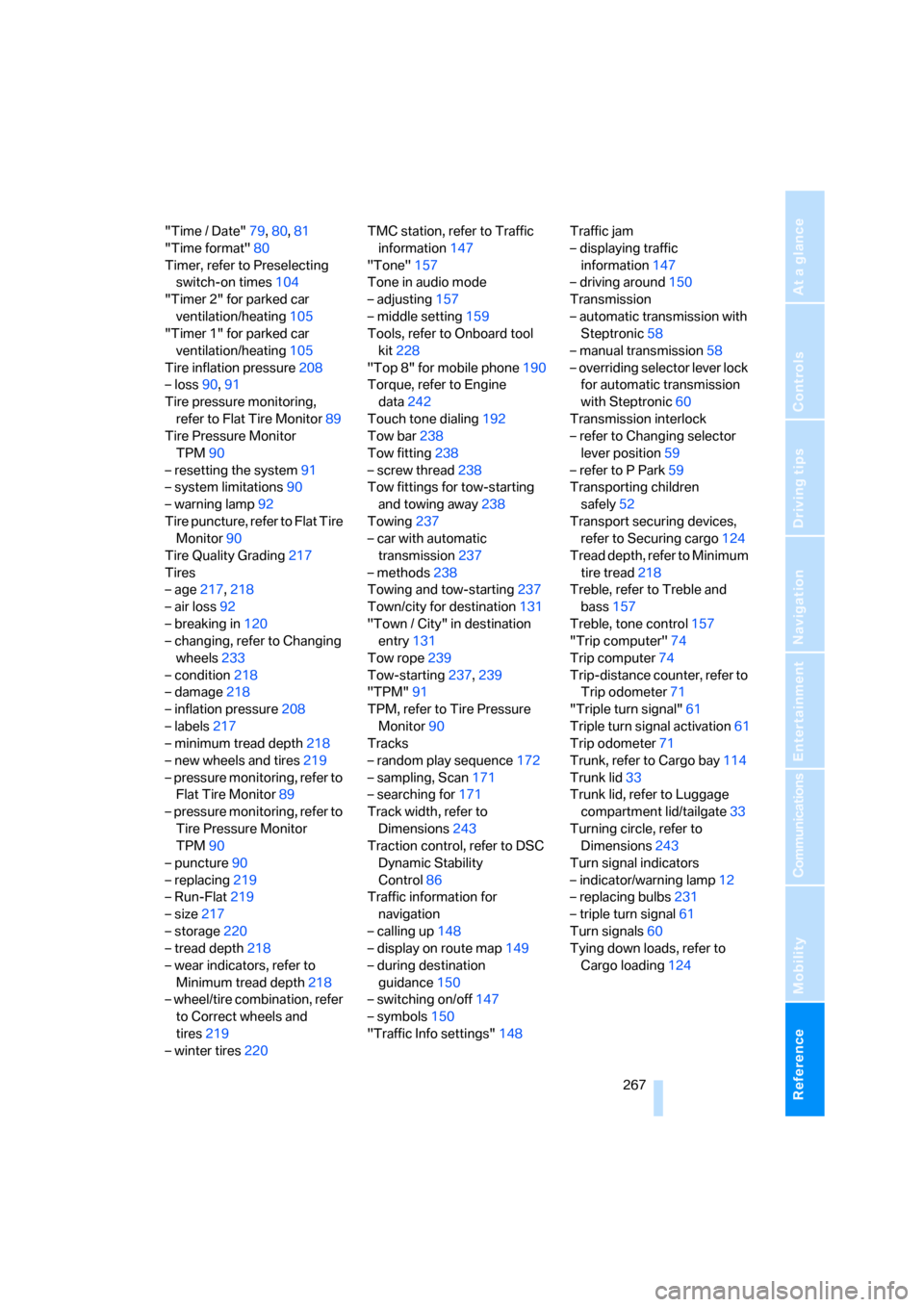
Reference 267
At a glance
Controls
Driving tips
Communications
Navigation
Entertainment
Mobility
"Time / Date"79,80,81
"Time format"80
Timer, refer to Preselecting
switch-on times104
"Timer 2" for parked car
ventilation/heating105
"Timer 1" for parked car
ventilation/heating105
Tire inflation pressure208
– loss90,91
Tire pressure monitoring,
refer to Flat Tire Monitor89
Tire Pressure Monitor
TPM90
– resetting the system91
– system limitations90
– warning lamp92
Tire puncture, refer to Flat Tire
Monitor90
Tire Quality Grading217
Tires
– age217,218
– air loss92
– breaking in120
– changing, refer to Changing
wheels233
– condition218
– damage218
– inflation pressure208
– labels217
– minimum tread depth218
– new wheels and tires219
– pressure monitoring, refer to
Flat Tire Monitor89
– pressure monitoring, refer to
Tire Pressure Monitor
TPM90
– puncture90
– replacing219
– Run-Flat219
– size217
– storage220
– tread depth218
– wear indicators, refer to
Minimum tread depth218
– wheel/tire combination, refer
to Correct wheels and
tires219
– winter tires220TMC station, refer to Traffic
information147
"Tone"157
Tone in audio mode
– adjusting157
– middle setting159
Tools, refer to Onboard tool
kit228
"Top 8" for mobile phone190
Torque, refer to Engine
data242
Touch tone dialing192
Tow bar238
Tow fitting238
– screw thread238
Tow fittings for tow-starting
and towing away238
Towing237
– car with automatic
transmission237
– methods238
Towing and tow-starting237
Town/city for destination131
"Town / City" in destination
entry131
Tow rope239
Tow-starting237,239
"TPM"91
TPM, refer to Tire Pressure
Monitor90
Tracks
– random play sequence172
– sampling, Scan171
– searching for171
Track width, refer to
Dimensions243
Traction control, refer to DSC
Dynamic Stability
Control86
Traffic information for
navigation
– calling up148
– display on route map149
– during destination
guidance150
– switching on/off147
– symbols150
"Traffic Info settings"148Traffic jam
– displaying traffic
information147
– driving around150
Transmission
– automatic transmission with
Steptronic58
– manual transmission58
– overriding selector lever lock
for automatic transmission
with Steptronic60
Transmission interlock
– refer to Changing selector
lever position59
– refer to P Park59
Transporting children
safely52
Transport securing devices,
refer to Securing cargo124
Tread depth, refer to Minimum
tire tread
218
Treble, refer to Treble and
bass157
Treble, tone control157
"Trip computer"74
Trip computer74
Trip-distance counter, refer to
Trip odometer71
"Triple turn signal"61
Triple turn signal activation61
Trip odometer71
Trunk, refer to Cargo bay114
Trunk lid33
Trunk lid, refer to Luggage
compartment lid/tailgate33
Turning circle, refer to
Dimensions243
Turn signal indicators
– indicator/warning lamp12
– replacing bulbs231
– triple turn signal61
Turn signals60
Tying down loads, refer to
Cargo loading124